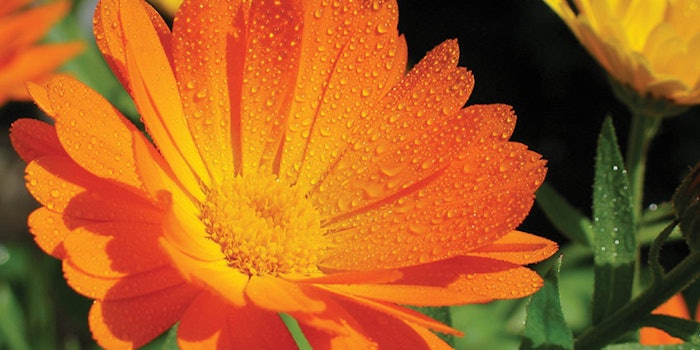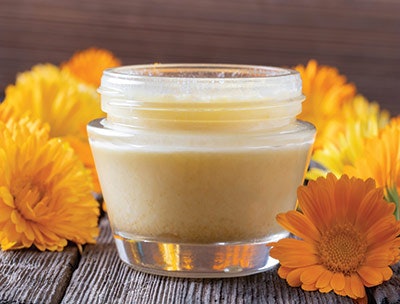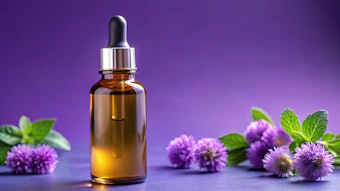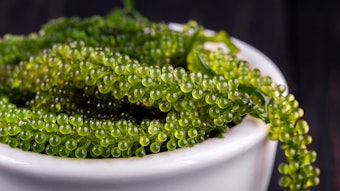
Bright and cheerful, marigolds were considered a symbol of happiness to the ancient Romans1—which is, no doubt, a boost we could all use right about now. And, with planting season upon us and Mother’s Day around the corner, pot marigold, or Calendula officinalis (C. officinalis or calendula), seems a good choice for this month’s “Jar Deconstructed.” As a point of clarification, WebMD notes that calendula often is confused for the ornamental marigold of the Tagets genus, which is typically used in vegetable gardens.2 This article is focused on the C. officinalis plant.
Calendula is believed to have originated in southern Europe, in Mediterranean areas and parts of Asia, although it is now cultivated all over the world. It is an annual plant that blooms abundantly almost anywhere that it is grown. In fact, according to the Garden Guides website,1 the ancient Romans named this plant calendula because they noticed it blooming on the first day of every month (“calends”).
The plant was a symbol of joy and happiness in their gardens not only for its bright blossoms, but also because it provided a continuous supply of flowers and leaves to use in cooking and medicine. For example, calendula was common in German soups and stews, for which it earned the nickname “pot marigold.” The flowers are traditional ingredients in Mediterranean and Middle Eastern dishes as well, and the bright-colored petals were even used to add color to butter and cheese; or to dye fabrics and hair.1, 3
The Romans and Greeks, among others, also used golden calendula in rituals and ceremonies. In relation, one of calendula’s nicknames became “Mary’s Gold,” referring its use in early Catholic events in some countries.
Reported Applications
 According to an article published in Pharmacognosy Review,4 C. officinalis Linn., or pot marigold, has been traditionally used to treat inflammation in internal organs, gastrointestinal ulcers and menstrual cramps, as a diuretic, and for heavy sweating during convulsions. It also addresses inflammation of the oral and pharyngeal mucosa, wounds and burns and poor eyesight.
According to an article published in Pharmacognosy Review,4 C. officinalis Linn., or pot marigold, has been traditionally used to treat inflammation in internal organs, gastrointestinal ulcers and menstrual cramps, as a diuretic, and for heavy sweating during convulsions. It also addresses inflammation of the oral and pharyngeal mucosa, wounds and burns and poor eyesight.Calendula has been reported for cleansing and detoxifying benefits, and to treat chronic infections. The dried flower tops have been utilized for antipyretic (anti-fever), anti-tumor and scarring effects. Topical infusions of the flower are also said to serve as an antifungal, antimicrobial and antiseptic for wounds, and to address marks and freckles. The essential oil of the plant also has been reported to soothe the central nervous system.4
During the Civil War and World War I, calendula flowers were reportedly used on the battlefields to treat open wounds as antihemorrhagics and antiseptics, and they were used in dressing wounds to promote healing.1, 4 The plant was also employed as a remedy for measles, smallpox and jaundice, as well as rashes, dermatitis, bee stings, foot ulcers and varicosis.4
According to the Plants For A Future nonprofit organization,5 only the common, deep-orange calendula holds medicinal value but the whole plant, especially the flowers and leaves, has anti-inflammatory, antiseptic, antispasmodic, aperient, astringent, stimulant and wound healing properties. The leaves and flowers can be used fresh or dried. A tea of the petals increases circulation and, if taken regularly, can reportedly ease varicose veins. An application of the crushed stems to corns and warts will render them easily removable, and calendula can be taken as a supplement to speed wound healing.5
Active Entities
Considering the multitude of reported benefits, you might expect calendula to contain a wide variety of active constituents; and you’d be right. Work from the aforementioned Pharmacognosy Review underlined triterpene alcohols, triterpene saponins, flavonoids, carotenoids and polysaccharides as the major classes of phytoconstituents.4
More specifically, chemical analysis via high performance liquid chromatography (HPLC) revealed calendula flower extract contained ten primary actives: vitexin 11.40%, rutin 12.29%, quercetin-3-3 galactoside 12.64%, luteolin-7-glucoside 9.27%, quercetin-3-glucoside 7.38%, quercitrin 9.83%, myricetin 10%, luteolin 10.72%, apigenin 7.08% and kampferol 9.37%.6
Skin Care Benefits
Considering the phytonutrient-rich character of calendula, its traditional use in the treatment of various skin care applications for wound healing and inflammation makes good sense. In fact, its use has been reported in well over 200 cosmetic formulations including creams, lotions and even shampoos.4
Continue reading about the skin care and spa benefits in our Digital Magazine
References
- www.gardenguides.com/78027-history-calendula.html
- www.webmd.com/vitamins/ai/ingredientmono-235/calendula
- https://herbsocietyorg.presencehost.net/file_download/inline/4c3509e2-b57f-4383-a7e1-1ec4d0d362d5
- www.ncbi.nlm.nih.gov/pmc/articles/PMC3841996/
- https://pfaf.org/user/Plant.aspx?LatinName=Calendula+officinalis











